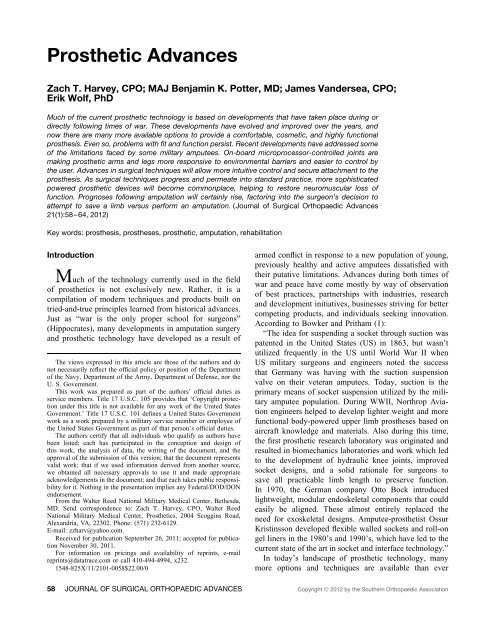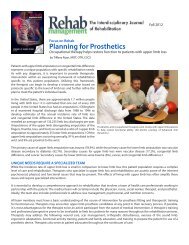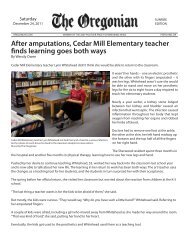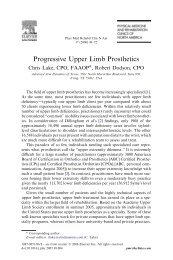Prosthetic Advances - Zach T. Harvey, CPO - Advanced Arm Dynamics
Prosthetic Advances - Zach T. Harvey, CPO - Advanced Arm Dynamics
Prosthetic Advances - Zach T. Harvey, CPO - Advanced Arm Dynamics
Create successful ePaper yourself
Turn your PDF publications into a flip-book with our unique Google optimized e-Paper software.
<strong>Prosthetic</strong> <strong>Advances</strong><br />
<strong>Zach</strong> T. <strong>Harvey</strong>, <strong>CPO</strong>; MAJ Benjamin K. Potter, MD; James Vandersea, <strong>CPO</strong>;<br />
Erik Wolf, PhD<br />
Much of the current prosthetic technology is based on developments that have taken place during or<br />
directly following times of war. These developments have evolved and improved over the years, and<br />
now there are many more available options to provide a comfortable, cosmetic, and highly functional<br />
prosthesis. Even so, problems with fit and function persist. Recent developments have addressed some<br />
of the limitations faced by some military amputees. On-board microprocessor-controlled joints are<br />
making prosthetic arms and legs more responsive to environmental barriers and easier to control by<br />
the user. <strong>Advances</strong> in surgical techniques will allow more intuitive control and secure attachment to the<br />
prosthesis. As surgical techniques progress and permeate into standard practice, more sophisticated<br />
powered prosthetic devices will become commonplace, helping to restore neuromuscular loss of<br />
function. Prognoses following amputation will certainly rise, factoring into the surgeon’s decision to<br />
attempt to save a limb versus perform an amputation. (Journal of Surgical Orthopaedic <strong>Advances</strong><br />
21(1):58–64, 2012)<br />
Key words: prosthesis, prostheses, prosthetic, amputation, rehabilitation<br />
Introduction<br />
Much of the technology currently used in the field<br />
of prosthetics is not exclusively new. Rather, it is a<br />
compilation of modern techniques and products built on<br />
tried-and-true principles learned from historical advances.<br />
Just as “war is the only proper school for surgeons”<br />
(Hippocrates), many developments in amputation surgery<br />
and prosthetic technology have developed as a result of<br />
The views expressed in this article are those of the authors and do<br />
not necessarily reflect the official policy or position of the Department<br />
of the Navy, Department of the <strong>Arm</strong>y, Department of Defense, nor the<br />
U. S. Government.<br />
This work was prepared as part of the authors’ official duties as<br />
service members. Title 17 U.S.C. 105 provides that ‘Copyright protection<br />
under this title is not available for any work of the United States<br />
Government.’ Title 17 U.S.C. 101 defines a United States Government<br />
work as a work prepared by a military service member or employee of<br />
the United States Government as part of that person’s official duties.<br />
The authors certify that all individuals who qualify as authors have<br />
been listed; each has participated in the conception and design of<br />
this work, the analysis of data, the writing of the document, and the<br />
approval of the submission of this version; that the document represents<br />
valid work; that if we used information derived from another source,<br />
we obtained all necessary approvals to use it and made appropriate<br />
acknowledgements in the document; and that each takes public responsibility<br />
for it. Nothing in the presentation implies any Federal/DOD/DON<br />
endorsement.<br />
From the Walter Reed National Military Medical Center, Bethesda,<br />
MD. Send correspondence to: <strong>Zach</strong> T. <strong>Harvey</strong>, <strong>CPO</strong>, Walter Reed<br />
National Military Medical Center, <strong>Prosthetic</strong>s, 2004 Scoggins Road,<br />
Alexandria, VA, 22302. Phone: (571) 232-6129.<br />
E-mail: zzharv@yahoo.com.<br />
Received for publication September 26, 2011; accepted for publication<br />
November 30, 2011.<br />
For information on pricings and availability of reprints, e-mail<br />
reprints@datatrace.com or call 410-494-4994, x232.<br />
1548-825X/11/2101-0058$22.00/0<br />
armed conflict in response to a new population of young,<br />
previously healthy and active amputees dissatisfied with<br />
their putative limitations. <strong>Advances</strong> during both times of<br />
war and peace have come mostly by way of observation<br />
of best practices, partnerships with industries, research<br />
and development initiatives, businesses striving for better<br />
competing products, and individuals seeking innovation.<br />
According to Bowker and Pritham (1):<br />
“The idea for suspending a socket through suction was<br />
patented in the United States (US) in 1863, but wasn’t<br />
utilized frequently in the US until World War II when<br />
US military surgeons and engineers noted the success<br />
that Germany was having with the suction suspension<br />
valve on their veteran amputees. Today, suction is the<br />
primary means of socket suspension utilized by the military<br />
amputee population. During WWII, Northrop Aviation<br />
engineers helped to develop lighter weight and more<br />
functional body-powered upper limb prostheses based on<br />
aircraft knowledge and materials. Also during this time,<br />
the first prosthetic research laboratory was originated and<br />
resulted in biomechanics laboratories and work which led<br />
to the development of hydraulic knee joints, improved<br />
socket designs, and a solid rationale for surgeons to<br />
save all practicable limb length to preserve function.<br />
In 1970, the German company Otto Bock introduced<br />
lightweight, modular endoskeletal components that could<br />
easily be aligned. These almost entirely replaced the<br />
need for exoskeletal designs. Amputee-prosthetist Ossur<br />
Kristinsson developed flexible walled sockets and roll-on<br />
gel liners in the 1980’s and 1990’s, which have led to the<br />
current state of the art in socket and interface technology.”<br />
In today’s landscape of prosthetic technology, many<br />
more options and techniques are available than ever<br />
58 JOURNAL OF SURGICAL ORTHOPAEDIC ADVANCES Copyright © 2012 by the Southern Orthopaedic Association
efore. Dynamic response feet constructed predominantly<br />
of carbon fiber, urethane, and titanium provide good<br />
energy return and ground accommodation (2–9). Microprocessor<br />
knees have enabled safer, more versatile, and<br />
more efficient ambulation (10–14). Upper extremity devices<br />
are rapidly changing to include more degrees of<br />
freedom, and becoming more intuitive and responsive,<br />
as a direct result of government-funded initiatives (15).<br />
<strong>Prosthetic</strong> feet, knees, hands, and other components are<br />
available to suit virtually any specialized need or activity<br />
where a standard prosthesis is not appropriate (16). Interface<br />
and suspension are slowly improving as manufacturers<br />
compete to produce a better product. A myriad<br />
of aesthetic options are available, including stunningly<br />
realistic high definition silicone restorations, helping with<br />
acceptance of body image.<br />
Despite the vast number of products and techniques<br />
available for the prosthetist to attempt to restore the loss<br />
of limb(s), technological limitations persist. Perhaps the<br />
most critical part of the prosthesis is the socket and<br />
interface. Patients consistently rate comfort as being more<br />
important than either function or cosmesis (17). The most<br />
technologically sophisticated prosthesis will not be used<br />
if it is not comfortable. The struggle to provide the perfect<br />
socket requires patience, perseverance, and acceptance<br />
when a realization is met that perfection is never fully<br />
attainable. That said, emerging materials and technologies<br />
continue to evolve and address the needs of the combatinjured<br />
amputee; these advances will gradually migrate to<br />
the arena of civilian amputee care in coming years.<br />
Lower extremity prosthetic advances<br />
It is well known that persons with amputation require<br />
increased energy expenditure to ambulate compared to<br />
age-matched non-amputees, and that the more proximal<br />
the level of amputation(s), the higher the increase in<br />
energy requirements (18–22). Additionally, in order to<br />
successfully ambulate, compensatory gait patterns are<br />
necessary but may lead to low back pain, premature<br />
degenerative joint disease, and variety of other maladies<br />
(23–29). The sound side ankle plantarflexes nearly 20<br />
degrees (30) during late stance and, among the lower<br />
extremity joints, is the greatest propellor during over<br />
ground gait (31). The iwalk BiOM (Bedford, MA) is the<br />
first commercially available foot and ankle to generate<br />
power in the form of active plantarflexion during late<br />
stance in gait (Fig. 1). Bionic and biomemetic controls<br />
acquire information from on-board sensors and send<br />
output to an actuator, which in turn moves the ankle as<br />
programmed. Preliminary data from a study conducted at<br />
the Center for the Intrepid in San Antonio, TX, has found<br />
the energy consumption of those unilateral transtibial<br />
BiOM wearers comparable to able-bodied controls (32).<br />
Whereas traditional prostheses generally restore only the<br />
skeletal loss following an amputation, the BiOM succeeds<br />
in restoring some motor aspects of neuromuscular loss as<br />
well. This technology should continue to improve with<br />
better battery technology, more sophisticated algorithms,<br />
and as other manufacturers attempt to compete in this<br />
market. Powered ankle and knee combinations are the<br />
next logical step of development and will follow suit<br />
with much of the recent progress made in upper extremity<br />
prosthetics. Pattern recognition shows some promise as a<br />
highly intuitive control scheme for the lower as well as<br />
upper extremity and would enhance the responsiveness of<br />
such systems (33).<br />
During level ground-walking, normal gait reveals 15 to<br />
20 degrees of knee flexion during loading response (34).<br />
This serves as a shock absorbing mechanism and is one of<br />
the key determinants of gait (35,36). Many microprocessor<br />
prosthetic knee joints are now designed with a feature<br />
called “stance flexion” and allow the user to push freely<br />
into the knee joint, allowing it to bend, and later pulling<br />
back in the socket to progress over the prosthesis. Few<br />
persons with transfemoral amputations, especially those<br />
with long, strong residual limbs, utilize this stance flexion<br />
feature (37,38), and prefer to power back in the prosthesis,<br />
keeping the knee joint locked throughout the entire phase<br />
of stance because of the feeling that the knee is giving<br />
way. It is highly possible that this contributes to the high<br />
prevalence of low-back pain associated with transfemoral<br />
amputees (39).<br />
Traditional prosthetic knees are passive in nature and<br />
are designed to balance stability with mobility during the<br />
gait cycle. Microprocessors have helped to improve the<br />
timing of this balance and even anticipate actions such<br />
as the stumble recovery feature of the Otto Bock Cleg<br />
(Minneapolis, MN). The Ossur Power knee (Aliso<br />
Viejo, CA) is the first commercially available knee to<br />
FIGURE 1 The BiOM powered ankle is the first commercially<br />
available device to deliver powered plantarflexion. This is thought to<br />
improve walking efficiency and lessen compensatory gait deviations.<br />
Photo courtesy of iWalk, Bedford, MA.<br />
Copyright © 2012 by the Southern Orthopaedic Association VOLUME 21, NUMBER 1, SPRING 2012 59
generate power during the gait cycle and actively assist in<br />
powered knee extension when exiting a chair and when<br />
ascending slopes and stairs. For flat ground ambulation,<br />
it is theorized that so long as stance flexion is utilized,<br />
the powered extension may lessen lower back strain and<br />
will improve energy efficiency during walking. Initial<br />
observations show that more people utilize stance flexion<br />
with the power knee than with traditional prosthetic knees.<br />
The Power Knee works during swing phase as well to<br />
equalize timing. It is not clear whether powered knee<br />
extension during swing phase is necessary compared to<br />
traditional prosthetic knee mechanics.<br />
Additionally, versatility is somewhat lacking in traditional<br />
knee joints. Some knees consistently yield while<br />
descending ramps and stairs while others consistently lock<br />
out under these conditions. Some knees are dangerously<br />
easy to swing forward while others require more deliberance,<br />
exertion, and effort. Current waterproof knees<br />
are not necessarily optimal for everyday use. When<br />
designing a knee that was versatile and durable enough<br />
to return some combat injured amputees to duty, the<br />
Military Amputee Research Program funded Otto Bock<br />
(Minneapolis, MN) to develop the X3 knee. The X3<br />
design requirements were that it be capable of walking on<br />
uneven ground, walking backward, carrying heavy loads,<br />
running on without adjusting the settings, and submerging<br />
in water. As a spin-off of the development, Otto Bock<br />
has very recently released less-ruggedized versions, the<br />
X2 (Fig. 2) and Genium, to be sold to the civilian sector<br />
as well as the military. While not powered technology<br />
in the sense that concentric power is being restored to<br />
the gait cycle, these knees deserve mention as emerging<br />
and promising technology as initial feedback has been<br />
outstanding and clinical observations have shown quick<br />
adaptation times, more utilization of stance flexion, and<br />
increased versatility during different walking patterns and<br />
terrain situations.<br />
Surgical advances<br />
Osseointegration is an emerging surgical technique for<br />
direct skeletal attachment of prostheses which may one<br />
day render sockets antiquated and obsolete for many<br />
patients. Although the attempted permanent coupling of<br />
metallic implants to the skeleton has been in use for<br />
decades in the maxillofacial and dental fields, this field has<br />
expanded to residual limbs in only the last two decades<br />
(40). Typically, a titanium or other alloy device is first<br />
inserted into the termimal bone of the residual limb, and<br />
then delivered through the skin via attachment of the<br />
prosthesis coupling during a second, staged procedure.<br />
This results in improved anchorage and responsiveness<br />
of prostheses, as well as greater proprioceptive feedback<br />
FIGURE 2 The X2 microprocessor knee (Otto Bock, Minneapolis,<br />
MN) has five on-board sensors that help to more intuitively balance<br />
the requirements of stability and mobility under various ambulation<br />
conditions.<br />
for the patient. Problems such as sweating, skin irritation<br />
from liners, volume fluctuations, and socket pain<br />
are thus also eliminated. Early results of these techniques<br />
are promising, with high rates of patient satisfaction<br />
following implantation in transfemoral and transhumeral<br />
amputees. Moderate revision and complication<br />
rates persist at present, and infection, fracture, and<br />
implant loosening remain concerns (41). The implantskin<br />
interface remains the critical, rate-limiting barrier to<br />
the further utilization and widespread adoption of these<br />
techniques (42–44). No ossoeintegrated device for major<br />
extremity amputations is currently FDA-approved for use<br />
in the United States; however, three European groups are<br />
actively implanting devices in amputees, and one U.S.<br />
group is performing animal trials (45).<br />
Until recently, prostheses for proximal upper extremity<br />
amputations were limited by the absence of a sufficient<br />
number of independent muscle groups to control separate<br />
actions of the elbow joint and terminal device, and the<br />
fact that the resulting nerve activation-prosthesis response<br />
couplings were not intuitive. Myoelectrics, or all prostheses,<br />
were therefore often rejected due to the significant<br />
neuromuscular retraining required and, even under the best<br />
circumstances, the cumbersome, sequential manipulation<br />
of each joint or device.<br />
60 JOURNAL OF SURGICAL ORTHOPAEDIC ADVANCES Copyright © 2012 by the Southern Orthopaedic Association
FIGURE 3 Targetted Muscle Reinnervation is a surgical procedure<br />
intended to improve the ability for the user to control the movements<br />
of the prosthesis. As surgical techniques continue to advance, more<br />
sophisticated prosthetic devices will be possible to operate. Photo<br />
courtesy of <strong>Advanced</strong> <strong>Arm</strong> <strong>Dynamics</strong>, Redondo Beach, CA.<br />
Targeted muscle reinnervation (TMR) is a novel amputation<br />
revision procedure, developed by Kuiken and Dumanian<br />
(46–49) wherein motor nerves whose primary<br />
target muscle groups have been lost are re-implanted into<br />
deliberately dennervated proximal muscles (Fig. 3). This<br />
produces an increased number of independent control sites<br />
for myoelectric prostheses, which can then be myoelectrically<br />
coupled with actions that are intuitively associated<br />
with the specific nerve(s). The result is the ability to simultaneously,<br />
rather than sequentially, manipulate multiple<br />
joints or devices and perform multiple prosthetic actions<br />
instinctively. At present, the procedure is most useful for<br />
proximal levels such as transhumeral amputations and<br />
shoulder disarticulations, and is usually performed as a<br />
delayed revision procedure, although acute TMR may<br />
prove feasible in the near future.<br />
<strong>Advanced</strong> pattern recognition (APR) refers to the use<br />
of computer algorithms to decipher surface electrode data<br />
and subsequently associate specific signal patterns with<br />
the appropriate prosthesis response for patients who have<br />
undergone TMR (47). For example, the patient repetitively<br />
thinks about closing his hand, and the electrode<br />
signals associated with this action are then programmed<br />
into the myoelectic prosthesis to generate the desired<br />
response. This permits even more rapid, intuitive, and fluid<br />
device control. Early results of both techniques have been<br />
promising.<br />
Additionally, a number of new implantable electrodes<br />
have been developed to improve myoelectric device<br />
control. These most commonly amplify peripheral nerve<br />
signals and thus improve the prosthesis responsiveness<br />
via a more reliable neuromuscular unit-prosthesis interface<br />
and/or permit the reception of signals from individual<br />
muscle groups, allowing more precise prosthesis control<br />
(50–56). Prototype electrodes designed for intracranial<br />
implantation have also been developed to permit myoelectric<br />
prosthesis control directly via signals transmitted from<br />
the cortical homunculous (50,57–59).<br />
Upper extremity prosthetic advances<br />
Upper extremity prosthetics devices have made profound<br />
advancements in recent years. There have been<br />
new surgical advancements in upper extremity amputation<br />
techniques and residual limb-prosthesis interfaces<br />
and several advancements in upper extremity prosthetic<br />
components.<br />
One of the greatest challenges with upper extremity<br />
prosthetics has been patient acceptance. Recent studies<br />
have found higher replacement and use rates and lower<br />
abandonment rates of upper extremity prostheses among<br />
Operation Enduring Freedom (OEF) and Operation Iraqi<br />
Freedom (OIF) combat-wounded service members compared<br />
to those from the Vietnam era (60,61). A higher<br />
acceptance rate amongst wounded warriors from OEF/OIF<br />
can be attributed to several factors including improved<br />
technology for upper extremity prostheses (60), increased<br />
rehabilitation and occupational therapy time, and a general<br />
cultural acceptance of a blending between man and<br />
machine. New terms have risen in modern culture to<br />
describe the blend of man and machine such as “cyborg”<br />
and “bionic.” Although myoelectric prosthesis have been<br />
available since the 1960’s and early 1970’s, most patients<br />
fit with upper extremity devices in the civilian world have<br />
used body-powered prosthetic devices. With advancements<br />
in surgical techniques, new requirements will<br />
become commonplace amongst upper extremity components.<br />
In the past, myoelectric prostheses would have<br />
to be controlled sequentially, i.e. flex elbow-lock elbow,<br />
rotate wrist–open hand-close hand. Work is being done<br />
to combine these actions into simultaneous control with<br />
all actions, or at least multiple actions, taking place at the<br />
same time. This increased simultaneous control will allow<br />
the upper extremity prosthesis to function faster and more<br />
efficiently.<br />
As a result of cooperative of government initiatives<br />
and investment, such as the Defense <strong>Advanced</strong> Research<br />
Projects Agency funding, educational research programs,<br />
and private industry interests, there have been promising<br />
recent advances in upper extremity prosthetics. Recent<br />
work includes development of prosthetic arms that have<br />
more degrees of freedom than current technology; some<br />
experimental prostheses have up to 27 degrees of<br />
freedom (15).<br />
Several manufacturers are developing externally powered,<br />
microprocessor TMR-compatable elbows (Otto<br />
Bock TMR Dynamic <strong>Arm</strong>, Motion Control Utah TMR,<br />
and the Boston TMR) for use with multiple simultaneous<br />
Copyright © 2012 by the Southern Orthopaedic Association VOLUME 21, NUMBER 1, SPRING 2012 61
FIGURE 4 Recently, a number of prosthetic hands have been<br />
introduced to market, including the iLimb pulse (Touch Bionics,<br />
Hiliard, OH), which allow individual finger movement and variation of<br />
grip position. Photo courtesy of <strong>Advanced</strong> <strong>Arm</strong> <strong>Dynamics</strong>, Redondo<br />
Beach, CA.<br />
inputs, allowing simultaneous control of up to several<br />
elbow functions. The microprocessor in the elbow acts<br />
like a computer server, processing the myoelectric signal<br />
and sending it to the desired powered device (elbow, wrist,<br />
or hand). TMR-compatible elbows can process the signals<br />
from multiple inputs simultaneously. This allows the user<br />
simultaneous control of the components of the prosthesis;<br />
wrist, hand, and elbow more closely mimicking the movement<br />
of the natural human arm.<br />
Recently, there have been several new multi-articulating<br />
prosthetic hands that have come to market. These multiarticulation<br />
hands have multiple motors to control different<br />
fingers and different hand positions. All of the<br />
multi-articulating hands have several pre-programmed<br />
hand positions that the user can select from such as:<br />
finger point, lateral key pinch, power grasp, mouse click,<br />
precision pinch, opposition, and soon-to-be-added wrist<br />
flexion and extension. Once the hand position is selected,<br />
using myoelectric signals or switches, the user can use<br />
myoelectric signals to control the opening and closing<br />
of the hand with the particular hand position selected.<br />
Multi-articulating hands include: the Michelangelo from<br />
Otto Bock, iLimb-Pulse from Touch Bionics (Fig. 4), and<br />
BeBionic V2 from Steeper.<br />
Conclusion<br />
Our experience working with hundreds of military<br />
amputees from initial injury to years following amputation<br />
has provided a wealth of feedback. <strong>Advances</strong> in<br />
surgical and prosthetic technology continue to emerge<br />
and, in comparison to past wars, have led to improved<br />
outcomes and restored mobility for even the most severely<br />
injured wounded warriors. Nonetheless, much “state of the<br />
art” technology is not particularly new and many recent<br />
developments must move forward past the prototype stage<br />
in order to continue true progress. As advanced surgical<br />
techniques become more mainstream, continued prosthetic<br />
component advancements will also be required. The ultimate<br />
goal of prosthetic science is to restore each amputee<br />
to his or her pre-morbid level of function; towards this<br />
end, much work remains to be done.<br />
References<br />
1. Smith, D.G., Michael, J.W., Bowker, J.H. Atlas of Amputations and<br />
Limb Deficiencies. Rosemont : American Academy of Orthopaedic<br />
Surgeons, 2004.<br />
2. Edelstein, J.E. <strong>Prosthetic</strong> feet. State of the Art. Phys. Ther.<br />
68:1874–81, 1988.<br />
3. Laferrier, J.Z., Gailey, R. <strong>Advances</strong> in Lower-limb <strong>Prosthetic</strong><br />
Technology. Phys. Med. Rehab. Clin. N. Am. 21:87–110, 2010.<br />
http://dx.doi.org/10.1016/j.pmr.2009.08.003<br />
4. Hafner, B.J., Sanders, J.E., Czerniecki, J.M., Fergason, J. Transtibial<br />
energy-storage-and-return prosthetic devices: a review of energy<br />
concepts and a proposed nomenclature. J. Rehabil. Res. Dev.<br />
39(1):1–11, 2002.<br />
5. Friel, K. Componentry for lower extremity prostheses. J. Am. Acad.<br />
Orthop. Surg. 13(5):326–35, 2005.<br />
6. Torburn, L., Perry, J., Ayyappa, E., Shanfield, S.L. Belowknee<br />
amputee gait with dynamic elastic response prosthetic<br />
feet: a pilot study. J. Rehabil. Res. Dev. 27(4):369–84, 1990.<br />
http://dx.doi.org/10.1682/JRRD.1990.10.0369<br />
7. Graham, L.E., Datta, D., Heller, B., Howitt, J., Pros, D. A comparative<br />
study of conventional and energy-storing prosthetic feet in<br />
high-functioning transfemoral amputees. Arch Phys Med Rehabil.<br />
88(6):801–6, 2007. http://dx.doi.org/10.1016/j.apmr.2007.02.028<br />
8. Barr, A.E., Siegel, K.L., Danoff, J.V., et al. Biomechanical<br />
comparison of the energy-storing capabilities of SACH and Carbon<br />
Copy II prosthetic feet during the stance phase of gait in a person<br />
with below-knee amputation. Phys. Ther. 72(5):344–54, 1992.<br />
9. Postema, K., Hermens, H., de Vries, J., Koopman, H., Eisma, W.<br />
Energy storage and release of prosthetic feet, Part 1: biomechanical<br />
analysis related to user benefits. Pros. Orth. Int. 21:17–27, 1997.<br />
10. Buell, N.C., Willingham, L.L., Allyn, K.J., Hafner, B.J., Smith,<br />
D.G., eds. Evaluation of gait style of hill descent for lower<br />
limb amputees. Hong Kong: The 11th World Congress of the<br />
International Society for <strong>Prosthetic</strong>s and Orthotics, 2004.<br />
11. Chin, T., Sawamura, S., Shiba, R., et al. Effect of an<br />
Intelligent Prosthesis (IP) on the walking ability of young<br />
transfemoral amputees: comparison of IP users with ablebodied<br />
people. Am. J. Phys. Med. Rehabil. 82(6):447–51, 2003.<br />
http://dx.doi.org/10.1097/01.PHM.0000069191.20125.38<br />
12. Johansson, J.L., Sherrill, D.M., Riley, P.O., Bonato, P., Herr, H. A<br />
clinical comparison of variable-damping and mechanically passive<br />
prosthetic knee devices. Am. J. Phys. Med. Rehabil. 84(8):563–75,<br />
2005. http://dx.doi.org/10.1097/01.phm.0000174665.74933.0b<br />
13. Hafner, B.J., Willingham, L.L., Buell, N.C., Allyn, K.J., Smith, D.G.<br />
Evaluation of function, performance, and preference as transfemoral<br />
amputees transition from mechanical to microprocessor control of<br />
the prosthetic knee. Arch. Phys. Med. Rehabil. 88(2):207–17, 2007.<br />
http://dx.doi.org/10.1016/j.apmr.2006.10.030<br />
14. Kahle, J.T., Highsmith, M.J., Hubbard, S.L. Comparison of<br />
nonmicroprocessor knee mechanism versus C-Leg on Prosthesis<br />
Evaluation Questionnaire, stumbles, falls, walking tests, stair<br />
descent, and knee preference. J. Rehabil. Res. Dev. 45(1):1–14,<br />
2008. http://dx.doi.org/10.1682/JRRD.2007.04.0054<br />
62 JOURNAL OF SURGICAL ORTHOPAEDIC ADVANCES Copyright © 2012 by the Southern Orthopaedic Association
15. Ling, G. DARPA. [Online] [Cited: September 19, 2011.]<br />
http://www.darpa.mil/Our Work/DSO/Programs/Revolutionizing<br />
<strong>Prosthetic</strong>s.aspx.<br />
16. <strong>Harvey</strong>, Z., Potter, B.K. Prostheses for major extremity amputations.<br />
[book auth.] Belmont PJ Owens BD. Combat orthopedic surgery.<br />
Thorofare : SLACK Inc, 2011.<br />
17. Legro, M.W., Reiber, G., del Aguila, M., et al. Issues of importance<br />
reported by persons with lower limb amputations and prostheses. J.<br />
Rehabil. Res. Dev. 36(3):155–63, 1999.<br />
18. Waters, R., Perry, J., Antonelli, D., Hislop, H. Energy cost of<br />
walking amputees: the influence of level of amputation. J. Bone<br />
Joint Surg. 58A:42–46, 1976.<br />
19. Buckley, J.G., Spence, W.D., Solomonidis, S.E. Energy cost of<br />
walking: comparison of “Intelligent prosthesis” with conventional<br />
mechanism. Arch. Phys. Med. Rehabil. 78:330–3, 1997.<br />
http://dx.doi.org/10.1016/S0003-9993(97)90044-7<br />
20. Waters, R., Mulroy, S. The energy expenditure of normal and pathologic<br />
gait. Gait Posture. 9:207–31, 1999. http://dx.doi.org/10.1016/<br />
S0966-6362(99)00009-0<br />
21. Gonzalez, E.G., Corcoran, P.J., Reyes, R.L. Arch. Energy<br />
expenditure in below-knee amputees: Correlation with stump length.<br />
Phys. Med. Rehabil. 55:111–19, 1974.<br />
22. Pagliarulo, M.A., Waters, R., Hislop, H.J. Energy cost of walking<br />
of below-knee amputees having no vascular disease. Phys. Ther.<br />
59:538–42, 1979.<br />
23. Burke, M.J., Roman, V., Wright, V. Bone and joint changes<br />
in lower limb amputees. Ann Rheum Dis. 37(3):252–4, 1978.<br />
http://dx.doi.org/10.1136/ard.37.3.252<br />
24. Ehde, D.M., Smith, D.G., Czerniecki, J.M., et al. Back<br />
pain as a secondary disability in persons with lower limb<br />
amputations. Arch. Phys. Med. Rehabil. 82(6):731–4, 2001.<br />
http://dx.doi.org/10.1053/apmr.2001.21962<br />
25. Lemaire, E.D., Fisher, F.R. Osteoarthritis and elderly amputee gait.<br />
Arch. Phys. Med. Rehabil. 75(10):1094–9, 1994. http://dx.doi.org/<br />
10.1016/0003-9993(94)90084-1<br />
26. Norvell, D.C., Czerniecki, J.M., Reiber, G.E., et al. The prevalence<br />
of knee pain and symptomatic knee osteoarthritis among veteran<br />
traumatic amputees and nonamputees. Arch. Phys. Med. Rehabil.<br />
83(3):487–93, 2005. http://dx.doi.org/10.1016/j.apmr.2004.04.034<br />
27. Morgenroth, D.C., Orendurff, M.S., Shakir, A., et al. The<br />
relationship between lumbar spine kinematics during gait<br />
and low-back pain in transfemoral amputees. Am. J. Phys.<br />
Med. Rehabil. 89(9):635–43, 2010. http://dx.doi.org/10.1097/PHM.<br />
0b013e3181e71d90<br />
28. Melzer, I., Yekutiel, M., Sukenik, S. Comparative study of<br />
osteoarthritis of the contralateral knee joint of male amputees who<br />
do and do not play volleyball. J. Rheumatol. 28(1):169–72, 2001.<br />
29. Nolan, L., Lees, A. The functional demands on the intact<br />
limb during walking for active trans-femoral and transtibial<br />
amputees. Prosthet. Orthot. Int. 24(2):117–25, 2000.<br />
http://dx.doi.org/10.1080/03093640008726534<br />
30. Murray, M.P., Kory, R.C., Clarkson, B.H. Walking patterns in<br />
healthy old men. J Gerontol. 24(2):169–79, 1969.<br />
31. Robertson, D., Winter, D. Mechanical energy generation absorption<br />
and transfer among segments during walking. J. Biomech.<br />
13:845–54, 1980. http://dx.doi.org/10.1016/0021-9290(80)90172-4<br />
32. [Online] iWalk. [Cited: August 15, 2011.] http://www.iwalk.com/<br />
Nov18.html.<br />
33. Hargrove, L.J., Simon, A.M., Lipschutz, R.D., et al. Realtime<br />
myoelectric control of knee and ankle motions for<br />
transfemoral amputees. J. Am. Med. Assoc. 305(15):1542–4, 2011.<br />
http://dx.doi.org/10.1001/jama.2011.465<br />
34. Winter, D.A. Overall principle of lower limb support during<br />
stance phase of gait. J. Biomech. 13(11):923–7, 1980.<br />
http://dx.doi.org/10.1016/0021-9290(80)90162-1<br />
35. Gard, S. A., Childress, D.S. What determines the vertical<br />
displacement of the body during normal walking? J. Pros. Orthot.<br />
13(3):4, 2001.<br />
36. Saunders, J.B., Inman, V.T., Eberhart, H.D. The major determinants<br />
in normal and pathological gait. J. Bone Joint Surg. Am. 35-<br />
A(3):543–58, 1953.<br />
37. Seroussi, R.E., Gitter, A., Czerniecki, J.M., et al. Mechanical work<br />
adaptations of above-knee amputee ambulation. Arch. Phys. Med.<br />
Rehabil. 7(11):1209–14, 1996. http://dx.doi.org/10.1016/S0003-<br />
9993(96)90151-3<br />
38. Segal, A.D., Orendurff, M.S., Klute, G.K., et al. Kinematic and<br />
kinetic comparisons of transfemoral and amputee gait using C-<br />
Leg and Mauch SNS prosthetic knees. J. Rehabil. Res. Dev.<br />
43(7):857–70, 2006. http://dx.doi.org/10.1682/JRRD.2005.09.0147<br />
39. Morgenroth, D.C., Orendurff, M.S., Shakir, A., et al. The<br />
relationship between lumbar spine kinematics during gait<br />
and low-back pain in transfemoral amputees. Am. J. Phys.<br />
Med. Rehabil. 89(8):635–45, 2010. http://dx.doi.org/10.1097/PHM.<br />
0b013e3181e71d90<br />
40. Br˚anemark, R., Br˚anemark, P.I., Rydevik, B., Myers, R.R.<br />
Osseointegration in skeletal reconstruction and rehabilitation: a<br />
review. J. Rehabil. Res. Dev. 38:175–81, 2001.<br />
41. Hagberg, K., Häggström, E., Uden, M., Br˚anemark, R. Socket<br />
versus bone-anchored trans-femoral prostheses: hip range of motion<br />
and sitting comfort. Prosthet. Orthot. Int. 29:153–63, 2005.<br />
http://dx.doi.org/10.1080/03093640500238014<br />
42. Sullivan, J., Uden, M., Robinson, K.P., Sooriakumaran, S.<br />
Rehabilitation of the trans-femoral amputee with an osseointegrated<br />
prosthesis: the United Kingdom experience. Prosthet. Orthot. Int.<br />
27:114–20, 2003. http://dx.doi.org/10.1080/03093640308726667<br />
43. Hagberg, K., Br˚anemark, R. One hundred patients treated<br />
with osseointegrated transfemoral amputation prostheses rehabilitation<br />
perspective. J. Rehabil. Res. Dev. 46:331–44, 2009.<br />
http://dx.doi.org/10.1682/JRRD.2008.06.0080<br />
44. Tillander, J., Hagberg, K., Hagberg, L., Br˚anemark, R.<br />
Osseointegrated titanium implants for limb prosetheses attachments:<br />
infectious complications. Clin. Orthop. Rel. Res. 468:2781–8, 2010.<br />
http://dx.doi.org/10.1007/s11999-010-1370-0<br />
45. Pendegrass, C.J., Gordon, D., Middleton, C.A., et al. Sealing<br />
the skin barrier around transcutaneous implants: in vitro study<br />
of keratinocyte proliferation and adhesion in response to surface<br />
modifications of titanium alloy. J. Bone Joint Surg. Br. 90:114–21,<br />
2008. http://dx.doi.org/10.1302/0301-620X.90B1.19580<br />
46. Kuiken, T.A., Dumanian, G.A., Lipschutz, R.D., Miller, L.A.,<br />
Stubblefield, K.A. The use of targeted muscle reinnervation for<br />
improved myoelectric prosthesis control in a bilateral shoulder<br />
disarticulation amputee. Prosthet. Orthot. Int. 28:245–53, 2004.<br />
47. Kuiken, T.A., Li, G., Lock, B.A., et al. Targeted muscle<br />
reinnervation for real-time myoelectric control of multifunction<br />
artificial arms. J. Am. Med. Assoc. 301:619–28, 2009.<br />
http://dx.doi.org/10.1001/jama.2009.116<br />
48. Kuiken, T.A., Miller, L.A., Lipschutz, R.D., et al. Targeted<br />
reinnervation for enhanced prosthetic arm function in a woman with<br />
a proximal amputation: a case study. Lancet. 369:371–80, 2007.<br />
http://dx.doi.org/10.1016/S0140-6736(07)60193-7<br />
49. Dumanian, G.A., Ko, J.H., O’Shaughnessy, K.D., et al. Targeted<br />
reinnervation for transhumeral amputees: current surgical technique<br />
and update on results. Plast. Reconstr. Surg. 124:863–9, 2009.<br />
http://dx.doi.org/10.1097/PRS.0b013e3181b038c9<br />
50. Sensinger, J., Pasquina, P.F., Kuiken, T. The future of artificial<br />
limbs. [book auth.] Cooper, R.A., Pasquina, P.F. Care of the combat<br />
amputee. Washington DC : Borden Institute, 2009.<br />
51. De Luca, C.J. Control of upper-limb prostheses: a case for<br />
neuroelectric control. J. Med. Eng. Technol. 2:57–61, 1978.<br />
http://dx.doi.org/10.3109/03091907809161756<br />
Copyright © 2012 by the Southern Orthopaedic Association VOLUME 21, NUMBER 1, SPRING 2012 63
52. Hoffer, J.A., Loeb, G.E. Implantable electrical and mechanical<br />
interfaces with nerve and muscle. Ann. Biomed. Eng. 8:351–60,<br />
1980. http://dx.doi.org/10.1007/BF02363438<br />
53. Edell, D.J. A peripheral- nerve information transducer for amputees:<br />
long-term multichannel recordings from rabbit peripheral- nerves.<br />
IEEE Trans. Biomed. Eng. 33:203–14, 1986. http://dx.doi.org/<br />
10.1109/TBME.1986.325892<br />
54. Development of an implanted neural control interface for artificial<br />
limbs. B, Andrews. Glasgow : 10th World Congress of the<br />
International Society of <strong>Prosthetic</strong>s and Orthotics, 2001.<br />
55. Childress, D., Weir, R.F. Control of limb prostheses. [book<br />
auth.] Michael, J.W., Bowker, J.H., eds Smith, D.G. Atlas<br />
of Amputations and Limb Deficiencies. Rosemont : American<br />
Academy of Orthopaedic Surgeons, 2004, pp. 173-195.<br />
56. Upshaw, B., Sinkjaer, T. Digital signal processing algorithms<br />
for the detection of afferent nerve activity recorded from<br />
cuff electrodes. IEEE Trans. Rehabil. Eng. 6:172–81, 1998.<br />
http://dx.doi.org/10.1109/86.681183<br />
57. Musallam, S., Corneil, B.D., Greger, B., et al. Cognitive<br />
control signals for neural prosthetics. Science. 305:258–62, 2004.<br />
http://dx.doi.org/10.1126/science.1097938<br />
58. Hochberg, L.R., Serruya, M.D., Friehs, G.M., et al. Neuronal<br />
ensemble control of prosthetic devices by a human with tetraplegia.<br />
Nature. 442:164–71, 2006. http://dx.doi.org/10.1038/nature04970<br />
59. Taylor, D.M., Tillery, S.I., Schwartz, A.B. Direct cortical control<br />
of 3D neuroprosthetic devices. Science. 296:1829–32, 2002.<br />
http://dx.doi.org/10.1126/science.1070291<br />
60. Reiber, G.E., McFarland, L.V., Hubbard, S., et al. Servicemembers<br />
and veterans with major traumatic limb loss from Vietnam war<br />
and OIF/OEF conflicts: Survey methods, participants, and summary<br />
findings. J. Rehab. Res. Dev. 47(4):275–297.<br />
61. McFarland, L.V., Hubbard Winkler, S.L., Heinemann, A.W.,<br />
et al. Unilateral upper-limb loss: satisfaction and prostheticdevice<br />
use in veterans and servicemembers from Vietnam and<br />
OIF/OEF conflicts. J. Rehabil. Res. Dev. 47(4):299–316, 2010.<br />
http://dx.doi.org/10.1682/JRRD.2009.03.0027<br />
64 JOURNAL OF SURGICAL ORTHOPAEDIC ADVANCES Copyright © 2012 by the Southern Orthopaedic Association










